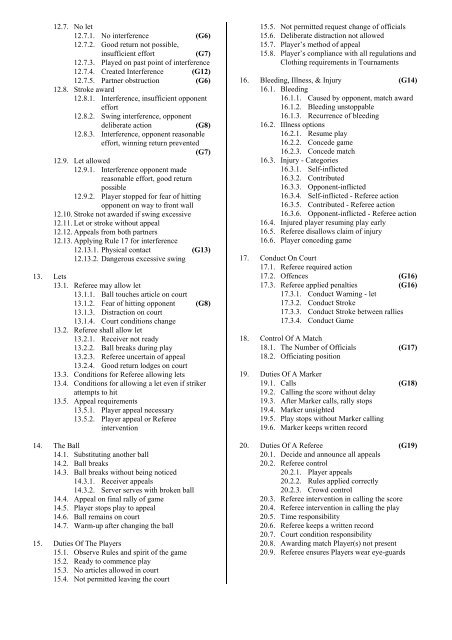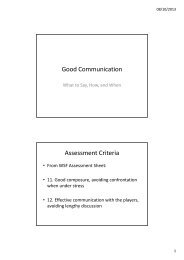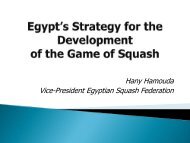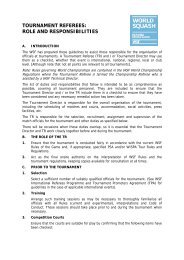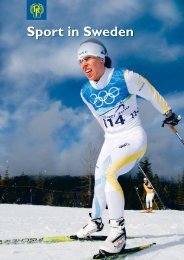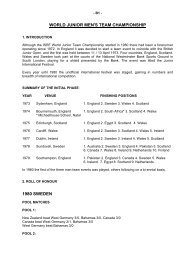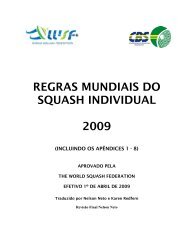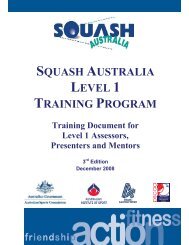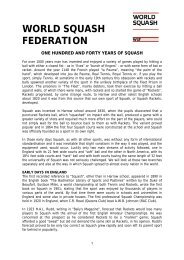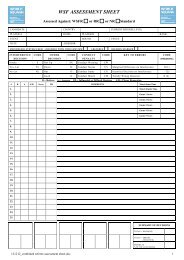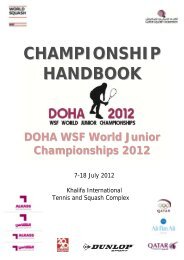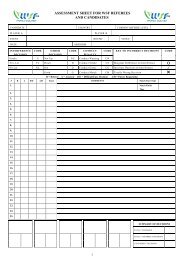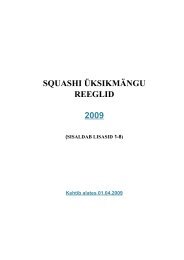International Doubles - World Squash Federation
International Doubles - World Squash Federation
International Doubles - World Squash Federation
You also want an ePaper? Increase the reach of your titles
YUMPU automatically turns print PDFs into web optimized ePapers that Google loves.
12.7. No let12.7.1. No interference (G6)12.7.2. Good return not possible,insufficient effort(G7)12.7.3. Played on past point of interference12.7.4. Created Interference (G12)12.7.5. Partner obstruction (G6)12.8. Stroke award12.8.1. Interference, insufficient opponenteffort12.8.2. Swing interference, opponentdeliberate action(G8)12.8.3. Interference, opponent reasonableeffort, winning return prevented(G7)12.9. Let allowed12.9.1. Interference opponent madereasonable effort, good returnpossible12.9.2. Player stopped for fear of hittingopponent on way to front wall12.10. Stroke not awarded if swing excessive12.11. Let or stroke without appeal12.12. Appeals from both partners12.13. Applying Rule 17 for interference12.13.1. Physical contact (G13)12.13.2. Dangerous excessive swing13. Lets13.1. Referee may allow let13.1.1. Ball touches article on court13.1.2. Fear of hitting opponent (G8)13.1.3. Distraction on court13.1.4. Court conditions change13.2. Referee shall allow let13.2.1. Receiver not ready13.2.2. Ball breaks during play13.2.3. Referee uncertain of appeal13.2.4. Good return lodges on court13.3. Conditions for Referee allowing lets13.4. Conditions for allowing a let even if strikerattempts to hit13.5. Appeal requirements13.5.1. Player appeal necessary13.5.2. Player appeal or Refereeintervention14. The Ball14.1. Substituting another ball14.2. Ball breaks14.3. Ball breaks without being noticed14.3.1. Receiver appeals14.3.2. Server serves with broken ball14.4. Appeal on final rally of game14.5. Player stops play to appeal14.6. Ball remains on court14.7. Warm-up after changing the ball15. Duties Of The Players15.1. Observe Rules and spirit of the game15.2. Ready to commence play15.3. No articles allowed in court15.4. Not permitted leaving the court15.5. Not permitted request change of officials15.6. Deliberate distraction not allowed15.7. Player’s method of appeal15.8. Player’s compliance with all regulations andClothing requirements in Tournaments16. Bleeding, Illness, & Injury (G14)16.1. Bleeding16.1.1. Caused by opponent, match award16.1.2. Bleeding unstoppable16.1.3. Recurrence of bleeding16.2. Illness options16.2.1. Resume play16.2.2. Concede game16.2.3. Concede match16.3. Injury - Categories16.3.1. Self-inflicted16.3.2. Contributed16.3.3. Opponent-inflicted16.3.4. Self-inflicted - Referee action16.3.5. Contributed - Referee action16.3.6. Opponent-inflicted - Referee action16.4. Injured player resuming play early16.5. Referee disallows claim of injury16.6. Player conceding game17. Conduct On Court17.1. Referee required action17.2. Offences (G16)17.3. Referee applied penalties (G16)17.3.1. Conduct Warning - let17.3.2. Conduct Stroke17.3.3. Conduct Stroke between rallies17.3.4. Conduct Game18. Control Of A Match18.1. The Number of Officials (G17)18.2. Officiating position19. Duties Of A Marker19.1. Calls (G18)19.2. Calling the score without delay19.3. After Marker calls, rally stops19.4. Marker unsighted19.5. Play stops without Marker calling19.6. Marker keeps written record20. Duties Of A Referee (G19)20.1. Decide and announce all appeals20.2. Referee control20.2.1. Player appeals20.2.2. Rules applied correctly20.2.3. Crowd control20.3. Referee intervention in calling the score20.4. Referee intervention in calling the play20.5. Time responsibility20.6. Referee keeps a written record20.7. Court condition responsibility20.8. Awarding match Player(s) not present20.9. Referee ensures Players wear eye-guards


